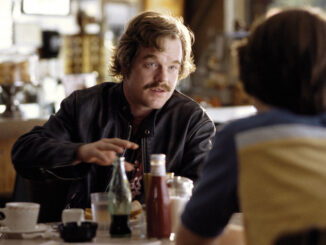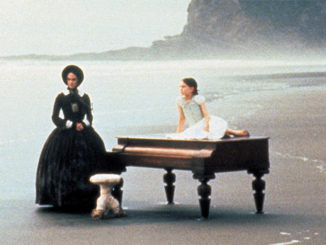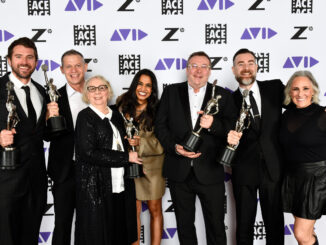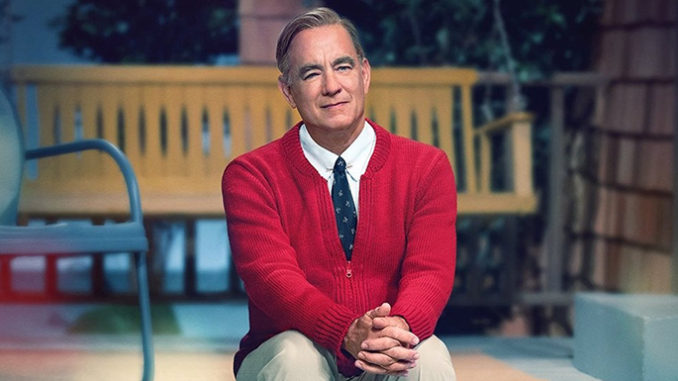
by Patrick Z. McGavin
Just a year following her prize-winning collaboration with director Marielle Heller, picture editor Anne McCabe, ACE, is back with another vibrant, sharp, and emotionally complex work in “A Beautiful Day in the Neighborhood.”
Inspired by the unlikely friendship between a jaded magazine journalist and the iconic children’s television host Fred Rogers, the movie examines the nature of creativity in charting the relationship between the pair, here played by Matthew Rhys and Tom Hanks.
From her debut work as an editor on Greg Mottola’s “The Daybreakers” (1996), McCabe, has also worked on such crucial works as Kenneth Lonergan’s Sundance Grand Prize winner “You Can Count on Me” (2000), as well as the prominent television series, “The Newsroom” (2012) and “Succession” (2018).
Coming on the heels of the Heller-directed deft literary forgery movie, “Can You Ever Forgive Me?,” McCabe talked with CineMontage about her past work and how it relates to her latest collaboration.
CineMontage: How beneficial was it to be working with the same director, Marielle Heller, on back-to-back projects?
Anne McCabe: It was great, because we just worked together on “Can You Ever Forgive Me?” We developed a dialogue and a way of communicating.
While we were on that movie, Marielle showed me the Tom Junod article (from Esquire Magazine) and talked about the movie, which at that point was called, “You Are My Friend.” I was thrilled to be asked to work on the second one. We had a trust; once you have worked with somebody before [you have that].
Was the dynamic similar to your previous film together?
While she is shooting, I am cutting the film. They were in Pittsburgh. The way I work, I usually try to send some scenes to give a sense of how things are being put together. After shooting, we had about a week break and I would submit an assembly. Then Marielle comes in and we usually spend the rest of the day together. Sometimes she will give me some notes.
We have an intensity when we work. We bounce ideas off each other. You bounce an idea off of her, and then she comes up with something and it makes you come up with more ideas. We worked very quickly to get to the director’s cut, so we could start screening it for people. It was a very focused amount of work.
Both films are dramatic reconstructions of events or build around actual people and real experiences. Does that limit you in any way, as far as the choices you make?
We have lots of choices. With both of the movies, the first cut was substantially longer than what ended up being the (finished) cut of the film. “Can You Ever Forgive Me?” was a good hour longer than what we ended up with, and “Beautiful Day in the Neighborhood” was maybe 45 minutes [longer].
It is not just about removing things to make it the right length. You are reshaping and reworking and sometimes lengthening pieces. “Let’s make the part where Tom Hanks is looking into the camera even longer.” There are times when you are really playing with it, and we need a whole other scene.
I’d say with both films, the only real similarity is that they are about unusual friendships and one of the people is more confident in who they are than the other person. The person who is struggling is an artist. They’re both writers. In terms of the characters, they are all very different. The look of the (new) film was entirely different, the
music was very different. This is something we played around a lot with in the cutting room, something I really enjoyed doing.
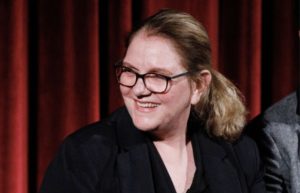
How influential was the Morgan Neville documentary, “Won’t You Be My Neighbor?” (2018), which looked at the life and career of Fred Rogers?
The documentary is incredible. I loved it. I grew up watching Mr. Rogers, as did Marielle. The movie was different than the documentary. The movie is more framed by the teachings of Mr. Rogers rather than a biography of what he was like as a kid.
There are things that are done so wonderfully in the documentary, like the footage at the Congressional hearing. That is an incredible scene, and so powerful and we have a clip of it in our movie. We shot the whole thing. The documentary has done so well, and you don’t really need to see that again.
You want to reference it, but do things in a different way than the documentary. It’s more like a companion piece, rather than, “Let’s do a mimic of this incredible documentary with actors playing real people.”
You are recreating the look, feel and rhythms of “Mr. Rogers’ Neighborhood.”Did you look at lot of the archival episodes as guidance?
Everybody who worked on the movie in principal positions did a ton of research watching all the shows. There’s a line in the movie, Andrea [the journalist’s wife] played by Susan Kelechi Watson, says, “Please don’t ruin my childhood.” It was important to respect the man and the show and not try to change everything.
The production designer (Jade Healy) did incredibly detailed recreations of the set. From my position, the way the show was edited: We measured how long the dissolves were, and we looked at the way things were cut. The actual show actually had a handmade quality to it. We didn’t want to make this a slick, or quick thing with weird dissolves, or something different.
You were able to cut Tom Hanks into the interview programs with Oprah Winfrey and Arsenio Hall!
It was a green screen. The coat Tom is wearing is the actual coat. We got it from Joanne Rogers, or maybe his nephew. It was very fun to see Tom Hanks in there, being interviewed by Oprah or the moment with Arsenio, showing Mr. Rogers was somebody who was able to laugh and had some humor about himself, like the scene with the tent.
We wanted to acknowledge those moments. It’s more about his character and his influence on the main character, who is Lloyd, and how he changed his life and made him rethink about being a parent.
Journalism is often about speed. The tempo in your film is much different.
That was the incredible thing about that era of journalism. People could take their time [to report things]. It’s not like the era for Twitter, where you have to put everything up so quickly. He had time to spend thinking about how this man had influenced him. He had multiple interviews [with Rogers], and he spent time with him and he was able to write about how this man changed his life.
Did you and Marielle Heller discuss pacing?
Absolutely. This was not going to be an action movie, where everything is jumping all over the place. I also work on “Succession,” a show that also does not move very quickly. One thing about Mr. Rogers is that he took his time, [he used] long pauses and there is a drama and tension to the pauses, when he is asking the questions. There is a different pace to this movie, and it builds slowly, and the tension builds slowly. It’s there; it’s subtle tension.
The centerpiece of the film are those interview exchanges between the writer and Mr. Rogers. How did you go about editing those?
I think what is interesting is that Lloyd [the writer] has this idea of what’s going to happen. He thinks they are going to be standard answers, and he is going to get a rise out of Mr. Rogers, or he thinks he has clocked Mr. Rogers, and the truth is, he hasn’t at all. There’s a kind of dance where Lloyd is stymied by the answers that Fred gives him.
In terms of the coverage, there is that high overhead [shot]. The way Fred is covered in the beginning is from behind and then Mr. Rogers turns things and we flip around to the front. There’s a kind of dance of who is in more control of the interview. Mr. Rogers is a soft, kind-hearted person, but he is also very strong. You see it behind Tom’s eyes that he is not going to flinch when Lloyd is asking him certain questions.
When he turns it onto Lloyd, he can’t quite lie to Mr. Rogers. He becomes very vulnerable. He can’t lie to Mr. Rogers, and Tom has this unflinching gaze and stares at him and Lloyd crumbles and has to admit the truth.
Did you study editing formally?
I did not go to film school. I was born in California but grew up in Boston. I went to school in New York. I went to Barnard College and I worked on a lot of Columbia Film School students’ shorts after college.
I did a lot of different things, working in film, production, casting, commercials, documentaries. When I settled on editing, it was the fix that was right for me because I am also a musician and a singer. Music and film are such a great combination.
I think that music is very much related to cutting and editing. You are using music [in editing], and I am constantly playing around with music in the cut. The rhythms of language and dialogue; music gives you a great ear training. You are very attuned to the rhythms and the way people speak, and [their] emphasis.
Do you still perform?
I like to sing and I like to sit in with bands. I listen to tons of music. Two of my brothers are professional musicians. [But] I am pretty busy with editing.
What gives you the greatest satisfaction or pleasure in your work as an editor?
[There’s a] moment in [“Beautiful Day”] where Lloyd says, “My dad is dying,” and we cut to Mr. Rogers and he is praying and then swimming, and Lloyd is driving home to see his dad after having rejected him for so long.
We cut that scene together, and then we put it the music, the Tracy Chapman song, “The Promise,” and every time I see that moment, I get choked up. To play that with an audience and see them get choked up the same way I did, seeing their reaction: that is incredibly satisfying.
On the flip side, I think it’s incredibly funny when Tom Hanks pulls out the King Friday the 13th (puppet that Mr. Rogers used) and starts talking in his puppet voice when Lloyd is trying to interview him. I find that incredibly funny and hilarious. Seeing an audience roll with laughter makes me feel great, because I think: That’s what I thought was funny.
You have also edited three episodes of the HBO program, “Succession.” Do you like having that versatility to move from television to film?
I am just trying to keep working. The more things we do, the more I am going to be employed. I also find working on television, you have a little bit more autonomy, but also the challenge of so much footage coming in and you have to cut quickly and [make] a lot of quick decisions. It really trains you to be fast.
Then you go to a movie, where you take your time and work things out and bounce your ideas off of somebody. Going back and forth keeps your eyes fresh, and allows you to look at things in a new way. Going back and forth has been incredibly helpful, as has working in documentary when I started. It’s a way of looking at footage and not simply repeating yourself.
How has your conception of the editor’s role evolved over time?
In the cutting room, on the one hand, it’s actually a very quiet place where you don’t have 45 different voices, like the way you are on sets.
The cutting room is a place where you can take time to look at, and think about, what is the crux of the movie and what is really going on here? The role of the editor is to have somebody who hopefully has good ideas, and be in a place where it’s okay to try things. You try out different things and you find out what works.
You can screen it for people and get reactions and comments, and then you come back into this quiet, safe place where you are allowed to sift through all of those things and come up with what you really think is important.
Patrick Z. McGavin is a Chicago-based cultural critic and film critic.


